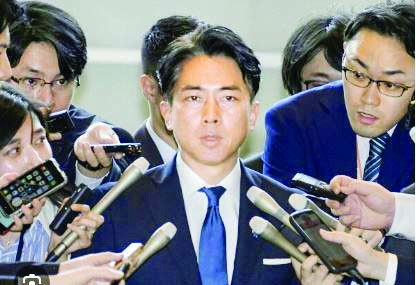
Shinjiro Koizumi tackles entrenched agricultural systems, aiming to modernize Japan’s farming, boost food security, and position for future political leadership.
Tokyo: Japan’s Agriculture minister, Taku Eto, made a Marie Antoinette-level serious gaffe. At a time of empty rice shelves in some locations, shortages in others, and record prices (that doubled in a year to even $29 for 5 kg in a Tokyo supermarket) he said that he never buys rice because he has so much presented to him by his supporters. After the uproar, Japan’s Prime Minister Shigeru Ishiba asked for Mr Eto’s resignation. To replace him, the PM has selected the telegenic Shinjiro Koizumi, scion of the political dynasty of former Prime Minister Junichiro Koizumi. A fellow alumnus of Columbia University, Shinjiro Koizumi is a masterful campaigner and in the Lower House of Parliament election campaign last October he was campaign chair for the ruling Liberal Democratic Party (LDP), crisscrossing the country while broadcasting on social media his daily lunch taken while on the move, and other new populist methods of attracting viral media attention.
Shinjiro Koizumi’s more serious side is a track record as a parliamentarian of working assiduously to reform the rigid and resistant-to-change agricultural system. Potential agricultural reform would also engender regional revitalization that is particularly important as Japan’s rural population sharply declines with even entire villages no longer in existence. Already, aging farmers, uncertain weather, panic hoarding by consumers and speculative activity by traders have impacted rice supply and prices. Interestingly, the world’s first commodity futures exchange was established in Dojima, Osaka, in year 1730 by the Tokugawa shogunate and it was set up for rice. The proposed reforms Shinjiro Koizumi has advocated for include building domestic and international food-security value chains.
Nevertheless, rice production has fallen considerably over the years, as has consumption. Partly the decline has been due to the shrinking population, but also because of the effort the government has made to diversify crops, micromanagement of the government subsidy system for rice, rice flour and livestock feed, bad weather, aging farmers, and panic hoarding. Government pays as much as $725 per acre to farmers for growing rice for livestock feed or rice flour, and that puts a double burden on consumers and taxpayers – they pay higher prices for rice as human food and pay higher taxes to enable that subsidy for livestock feed. Attempts to remove those market distorting subsidies have been thwarted.
The general malaise affecting agriculture therefore results in commercial banks only extending less than 10% of their loan portfolio to the agriculture sector in Japan and indeed the rest of Asia. The Asian Development Bank has recently highlighted that anomaly. Much work remains to address that imbalance as the currently favored sectors include construction, housing, industry and export/import trade.
The ministry Mr Koizumi now oversees, the Ministry of Agriculture, Forestry and Fisheries (MAFF) is a giant ministry with heavy capital resources and a vast network of organizations and entities ranging from banks to shops that sell fertilizers to procurement arms that buy rice, fruits, vegetables, and distribute them via their own stores, supermarkets; research and development institutions, and regulatory agencies. Japan was a major agricultural power in the past century and a leading contributor to the CGIAR world agricultural research and development system. A core of Japan’s agriculture is the federation of cooperatives (Japan Agricultural Cooperatives Group or JA) that dominates. It was originally set up as a network of local cooperatives with now over 10 million regular and non-regular members of Japan’s 125 million population. Over time, the national entity established policies for the whole federation and passed those down through the prefectures (states) organizations to local cooperatives, thus more resembling a corporation than a cooperative.
Also, a somewhat unique feature is that JA engages in a multiplicity of functions: produce marketing, banking credit, insurance and even hospital management leading to the quip “all you need is JA from cradle to grave”. Partly, those happened due to necessity as there were no banks or insurance companies in rural areas after the devastating World War II, and so the cooperatives were given those responsibilities and privileges to engage in more diverse economic activities ranging from agriculture to banking and insurance that other commercial entities do not have.
Naturally, reforming such an unwieldy, nearly 80 year old system has proven very challenging for every minister, particularly as members of JA, especially rice farmers, have been the traditional support base of the ruling Liberal Democratic Party. Nevertheless, because of the rapid decline of both the farm voters and JA executives who get Proportional Representation (PR) seats in parliament with their hats as LDP candidates, as well as the collapse of the agricultural policy triangle of MAFF executives, JA executives and LDP’s agriculture and forestry executives that held sway for decades, the time is ripe for major reforms. That does not mean merely eliminating small farmers and converting their land holdings into large corporate farming properties as some have advocated. The main mission is becoming sustaining regional communities. Needed changes include digital transformation, robotics, sensor innovation, and green agriculture.
Meanwhile, JA’s top brass views are no longer regarded as representing the interests of Japan’s farmers in Kantei or PMO of Japan. It is therefore also an opportune time for JA leadership to advance innovative ideas to enhance Japan’s food security and not solely focusing on farming and farm-commissions but also to more productively utilize the vast capital in its various arms including Norinchukin Bank, a major financial institution established to support the agricultural, forestry and fisheries industries. Norinchukin serves as a central bank for Japan’s agricultural cooperatives (JA), fishery cooperatives (JF) and forestry cooperatives.
Success in these reform initiatives would likely propel Shinjiro Koizumi to the prime ministership in the future. But “belling the cat” is no easy task and requires many categories of expertise and wisdom. That is the pressing challenge facing him and Japan’s vast agricultural enterprises as they strive for food security for Japan and the Asia-Pacific.
Dr Sunil Chacko holds degrees in medicine (Kerala), public health (Harvard) and an MBA (Columbia). He was Assistant Director of Harvard University’s Intl. Commission on Health Research, served in the Executive Office of the World Bank Group, and has been an Adjunct Professor and faculty member in the US, Canada, Japan and India.







